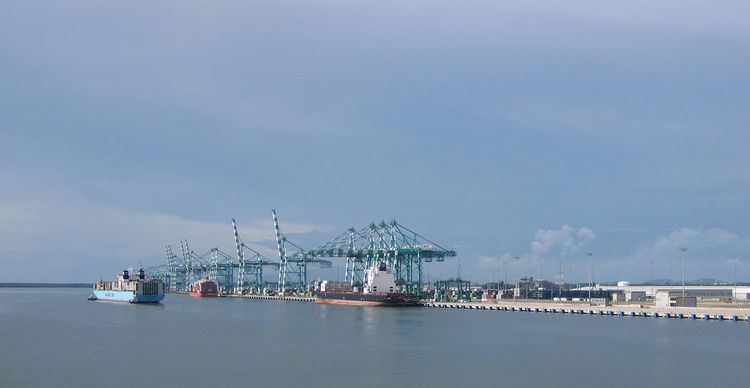Phone +60 7-504 2222 | ||
 | ||
Address Blok A, Wisma PTP, Jalan Pelabuhan Tanjung Pelepas, TST 507, 81560,, 81560 Gelang Patah, Johor, Malaysia Hours Closed now Friday9AM–5:30PMSaturdayClosedSundayClosedMonday9AM–5:30PMTuesday9AM–5:30PMWednesday9AM–5:30PMThursday9AM–5:30PMSuggest an edit Similar Profiles | ||
Rail line from port of tanjung pelepas to the pasir gudang to be upgraded
The Port of Tanjung Pelepas (PTP, UN/Locode: MYTPP) is a container port located in Johor Bahru District, Johor, Malaysia, and is part of the APM Terminals Global Terminal Network, which holds a minority share in the joint venture. Receiving its maiden vessel on 10 October 1999 on a three-month trial operation, it set a world record as the fastest growing port with 1 million twenty-foot equivalent units (TEU) of containers handled after 571 days of operations. The good performance sealed the port's fate, and it was officially launched by then Prime Minister of Malaysia, Tun Dr. Mahathir Mohamad, on 13 March 2000.
Contents
- Rail line from port of tanjung pelepas to the pasir gudang to be upgraded
- Jingga post port of tanjung pelepas ptp corporate video
- Location
- Growth
- Facilities
- References
Jingga post port of tanjung pelepas ptp corporate video
Location
The port itself is situated on the eastern mouth of the Pulai River in south-western Johor, Malaysia.
Growth
The port continues to register spectacular growth. At the end of 1999, the terminal handled 20,696 twenty-foot equivalent units (TEU), which rose to 423,710 TEU in 2000, 2.05 million TEU in 2001, and 2.67 million TEU in 2002, and 3.48 million TEU in 2003 outstripping Port Klang and thereby establishing itself as Malaysia's largest port. In 2004, it registered a 15.3% increase to 4,020,421 TEU, and came in as the world's 16th busiest container port. In 2005, PTP handled 4.2 million TEU, and 2006 an estimated 4.6 million TEU. In 2007, PTP handles a further 5.5 million TEU, a growth of 14.5 percent compared to 2006. In 2008 PTP handled 5.6 million TEU and PTP closed 2009 with a container throughput of 6.02 million TEUs which was 7.5% higher than 2008. For year 2010, the port handled 6.5 million TEU a total growth of 8% from 2009 and in 2011, PTP handled 7.5 million TEU with a growth of 15% from 2010. In 2012, PTP’s container throughput rose from 7.5 million to 7.7 million TEU with a growth of 2.4%. set a world record as the fastest growing port with 1 million twenty-foot equivalent units (TEU) of containers handled after 571 days of operations. The good performance sealed the port's fate, and it was officially launched by then Prime Minister of Malaysia, Tun Dr. Mahathir Mohamad, on 13 March 2000.
This accelerated growth hinges on the port's proximity to the busy sea lanes on which the Port of Singapore derived its growth and sustainability for nearly two centuries. Positioning itself as a choice alternative to Singapore's terminals, it highlights its proximity to the Tuas Second Link which leads to Singapore. Sustained growth after 2000 was also largely possible as Maersk Sealand, the world's largest container ship operator, took a 30% equity stake in the port's holding company, Seaport Terminal in a deal concluded on 17 August 2000, effectively shifting all of Maersk's operations to the new port from the Singaporean port by the end of that year. Maersk was once the largest operator in Singapore, and the shift represented a 10% drop in business there.
In 2002, Evergreen Marine Corporation, then the world's second largest shipping company after Maersk, also shifted its operations to PTP from Singapore. This event raised alarm bells in the Singaporean port, with widespread speculation in the shipping community that Evergreen's endorsement of PTP demonstrated that Maersk's move may not be an isolated one. Other lines have since also started direct services at PTP.
In 2012, the port announced that it will expand its quay by the addition of two berths worth MYR1.4 billion with a total of 14 berths. The length of the quay will increase by 0.7 km to the existing 4.32 km making it a 5.0 km long linear quay. It is expected that the two berths will be fully operational in the first quarter of 2014. The expansion project will increase the handling capacity to 10.4 million TEUs.[5]
Facilities
The current port offers 14 berths totaling 5 km of linear wharf length, and a 1.2 million square meters container yard which contains around 214,000 TEU in storage space, 38,000 ground slot and 5,080 reefer points.
The berths are serviced by 52 Super Post-Panamax quay cranes, 8 (EEE crane) with 25 rows outreach, 11 of which have a 22 rows outreach and dual hoist 40’ pick, 30 with 22 rows outreach and twin 20’ lift. The total capacity of the port today is over 10.5 million TEU per year with 174 rubber tyred gantry cranes and 390 Prime Movers operates around the container facility.[6]
Besides being connected directly to the main Malaysian expressways, the port is also linked to rail access which extends into Southern Thailand with a 4 track rail terminal. A 14 lanes gate terminal and 6 lanes FTZ (Free Trade Zone) ensure a smooth turnaround time for import and export containers. The port development area consists of 2,000 acres for the port terminal and 1,500 acres for the free trade zone. The port has a naturally deep harbor with a draft of 15 – 19 metres, and its turning basin of 720 metres allows for ships of any size to turn easily.[7]
The entire master plan of the port envisages over 95 berths with 150 million TEU terminal handling capacity making it the only port in South East Asia with long term potential to handle increasingly growing container traffic. The berths are expected to extend from the mouth of the Pulai River to Malaysia–Singapore Second Link.
